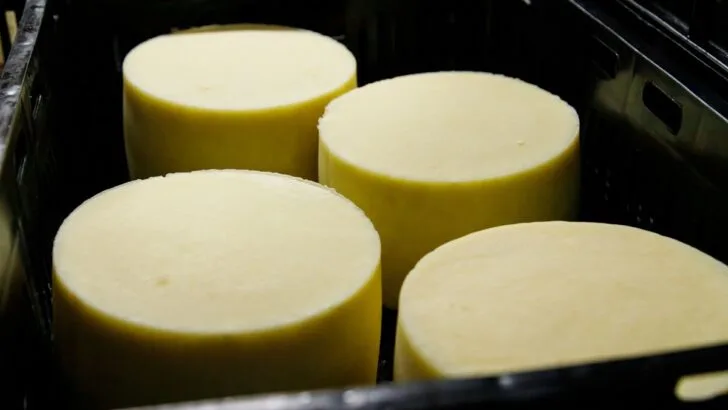If you’re a pasta aficionado, you probably use parmesan cheese quite a bit.
It is a traditional yet crucial ingredient in pasta. It magically improves everything, adds tons of flavor, makes everything creamier, and is simply irresistible.
However, if you have been working with it, you must know that sometimes it doesn’t melt the way you want it to, giving you a hard time. Why does this happen?
Parmesan cheese does melt, but it all varies depending on how fresh your parmesan is and what kind of parmesan you use. If you are using processed parmesan, chances are it will take longer than usual to melt.
On the other hand, if you want to melt it better and faster, use grated cheese rather than the whole.
Let’s dive deeper into the details to determine which type of parmesan melts better, which will become clumpy, along with what the ideal temperature is to melt parmesan.

What Are The Different Types Of Parmesan Cheese?
Before going into what factors make parmesan melt, let’s look at different types of parmesan cheese.
Ground Parmesan
Ground parmesan is defined as finely ground cheese in the form of tiny, nearly powder-like crumbs.
Companies that sell this product frequently add different ingredients to bulk it up, such as cellulose powder – or even different cheeses, such as Romano – in addition to additives to prolong its shelf life.
It is frequently used as a garnishing cheese or combined into recipes.
This is unlikely to melt, as it has been processed and may contain a variety of preservatives that hinder its likability from melting.
Parmigiano-Reggiano
This is 100% real Italian parmesan cheese. You buy it fresh, and it must adhere to strict certifications and top-notch guidelines from Italy to be labelled as such.
It must also be manufactured in specific locations throughout Italy.
If you see this name, you’re getting the real deal and authentic parmesan cheese that would melt in creamy holiness because it was made with rennet.
Pre-Shredded Parmesan
When you buy pre-shredded parmesan, it is already grated. But here we are talking about parmesan bags or tubs that have been processed and grated before arriving at the store.
Before buying this type of parmesan, you must know that these shreds are not made from fresh parmesan and will likely be clumpy or stringy when melted.
Freshly Grated Parmesan
Freshly grated parmesan is grated by hand. This is not a retail bag of grated parmesan but rather gratings prepared from a fresh block. This is often the type of parmesan you’ll get at a restaurant as well.
Do All Types Of Parmesan Melt?
This question has everyone scratching their heads: does all parmesan melt? It all comes down to the fact that Parmigiano-Reggiano is the forefather of parmesan.
For parmesan to be referred to as genuine, it must be manufactured in Italy.
Although the type of parmesan cheese we are familiar with and enjoy is not true Parmigiano-Reggiano, it can still be as scrumptious as the original one.
As long as it’s fresh, the non-authentic ones can also be used for melting.
This makes it your decking factor. It must be fresh parmesan if you want it to melt. The hardness of the parmesan tells if your cheese is fresh or not.
Clumpier cheese would be harder and might contain white spots. However, utilizing sprinkled parmesan or pre-grated parmesan will probably not get you far enough when it comes to melting it.
Perhaps you’ve already tried it, resulting in burnt, hard parmesan.
Parmesan is one of the most frequently used cheeses for pasta or lasagna. While it is often mixed into different pasta dishes and with several other ingredients when cooking, such as zucchini parmesan, it is also served cold.
It can also be cooked into some other dishes, but it’s even better if you are using it as a topping for other dishes, like a lasagna.
The finely shredded parmesan you slather on your lasagna or pizza or the top of your cooked pasta is not meant to melt.
The cheese has been heavily processed, and almost all of its melting ability has been lost.
On the other hand, some shredded parmesan might melt completely, whereas others might only slightly melt.
It all comes down to how fresh your parmesan is as well as whether it has been heavily processed.
In case you are struggling to melt your parmesan, then there must be a few factors to look upon. Fresh, real parmesan cheese melts exceptionally well and is the creamy portion of your feast that completes it.
It will get thickened slightly, but it melts. On the other hand, shredded or pre-grated parmesan might melt or might not.
It is related to the purity of the parmesan and the amount of processing it has to go through. And if you use finely grated parmesan, the bad news is that it will not result in good melting cheese.
How To Properly Melt Your Parmesan Cheese
Parmesan cheese is a cheaper version of Parmigiano-Reggiano cheese. This is a hard and granular Italian cheese. It is made from cow’s milk and has been aged for at least a year.
The boxes of parmesan cheese we see or buy at the grocery store are frequently not authentic parmesan cheese in the basic form.
However, worry not! Still, you are getting parmesan cheese, although it has been processed in a variety of ways by the time it is grated, packaged, or placed in a tub for sprinkle use.
The reliability of parmesan cheese is also affected by its processing.
Finally, the type of parmesan, whether it is processed or fresh, determines whether or not your cheese can melt.
If you’re having difficulty eating your parmesan cheese, it’s probably because it’s not fresh or young. Some of its properties will have changed, and it will simply not melt as quickly, crumbling, browning, or burning.
However, the older and perhaps more processed the cheese, the more commonly it will do this rather than melt.
What Is The Melting Time And Temperature Of Parmesan Cheese?
Let’s now look at the melting time and temperature that parmesan cheese takes on average.
Time
The time parmesan takes to melt also goes down to the type of parmesan you are working with.
It will vary greatly depending on whether you use high-quality, genuine parmesan or overly processed parmesan.
It will most likely melt instantly if you have fresh, real parmesan. Genuine parmesan needs to come into contact with heat to splash into a silky parmesan in addition to your sauce.
If it doesn’t melt when it comes into contact with heat, that it most probably because it isn’t authentic or fresh.
However, it could simply just not be the best quality parmesan, resulting in it being lumpy or stringy rather than creamy and melted.
If the parmesan is genuine and top-quality, it’ll still melt immediately.
If it’s not of high quality, you might have to work it vigorously for approximately 8 to 10 minutes to melt and not become clumpy.

Temperature
The temperature does not have to be extremely high to enhance the melting of your Parmigiano-Reggiano cheese.
This rugged, ground cheese with a lower melting point is a true parmesan delicacy.
Interestingly, while parmesan has a greater melting point than supple cheeses like mozzarella, it still does not require high temperatures to melt.
Real parmesan can typically be melted at around 180°F. Some other softer cheeses require only 130 to 150°F, which is substantially higher but still manageable.
If you attempt to bake it, it may be a different story, as the intense heat may cause a distinctive reaction, even if you only use parmesan as a seasoning on your baking dish.
It is more inclined to melt, turn brown, and stiffen together slightly. It’s still tasty, but it’s not creamy or melted.
At around 90°F, parmesan cheese will begin to melt. However, at this temperature, the milk fat in all cheeses begins to liquefy, and the cheese begins to soften.
This explains why parmesan that doesn’t melt completely will still melt some parts at some point.
Parmesan cheese contains very little moisture. Even if the parmesan melts, it might not completely melt. Parts of it might melt into creamy goodness, while others may remain in lumps.
Processed parmesan has a relatively strong acid content, causing it to turn clumpy or stringy rather than the melted creaminess you might have expected.
Final Words on If Parmesan Cheese Melts
Now you know a few factors that cause your parmesan cheese to melt, you must know what kind of cheese you are using.
The more natural or young the cheese is, the more it will melt. And the same goes for processed cheese. The more it is processed or aged, the more it becomes clumpy.
So, keep the check on your cheese type to melt your parmesan cheese perfectly. May your alfredo sauce and pasta never become clumpy.


